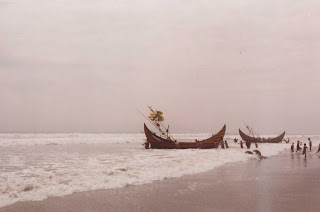Jamuna Bridge is the largest Bridge in Bangladesh and the 11th longest bridge in the world.It is constructed over the river jamuna, mightiest of the three major rivers of Bangladesh, and fifth largest in the world in terms of volumetric discharge. The bridge established a strategic link between the eastern and western parts of Bangladesh. It generates multifarious benefits for the people and especially,promotes inter-regional trade in the country. Apart from quick movement of goods and passenger traffic by road and rail, it facilitated transmission of electricity and natural gas, and integration of telecommunication links. ...

The bridge was constructed at a cost of $962 million. The cost of construction was shared by IDA, ADB, OECF of Japan, and the government of Bangladesh. Of the total, IDA, ADB and OECF supplied 22% each, and the remaining 34% was borne by Bangladesh. The components of the project's cost were: bridge and viaducts - $269 million (28%); river training works - $323 million (35%); roads and embankments - $71 million (7%); consultancy - $33 million (3%); land, resettlement and environment - $67 million (7%); establishment - $13 million (1%) and others - $186 million (19%).
Considering the fact that the width of the main channel does not exceed 3.5 km, and after making allowances for Floods, a bridge length of 5 km was considered adequate. In October 1995, one year after the commencement of physical work of the bridge, a bridge length of 4.8 km, instead of a flood-width of the river at 14 km, was finalised. This narrowing was essential to keep the overall project cost within economic viability. It has, however, required considerable river training work to keep the river under the bridge.
To withstand predicted scourge and possible EarthQuack, the bridge is supported on 80-85 m long and 2.5 m and 3.15 m diameter steel piles, which were driven by powerful (240-ton) hydraulic hammer. The superstructure of the bridge is pre-cast segments erected by the balanced cantilever method. Basic features of the bridge are: length (main part) - 4.8 km; width - 18.5 metre; spans - 49; deck segments - 1263; piles - 121; piers - 50; road lanes - 4; railway tracks - 2.

The impact of Jamuna Bridge on the nation is immense.The Jamuna River splits Bangladesh in half in terms of both areas and population. In the past, ferries plied across with an average waiting time of 36 hours for the more than 700 trucks that waited to board daily. Improving the flow of goods and passengers and connecting infrastructure from one side of the country to the other was critical and central to unlocking economic growth.More than 30 million people are now connected to the country’s transport and infrastructure network, and enjoy lower transport costs and quicker travel times.
Effects
- Transportation of natural gas, electricity and telecommunication is faster, cheaper and more reliable.
- Bus travel time from Dhaka to the trade city of Bogra was reduced from eight hours to four. Truck travel time from Dhaka to Bogra was reduced from 20 hours to 6 hours.
- Transport costs have been reduced and access to key consumption centers like Dhaka has improved. Average truck rates per ton went down 30 percent (from Tk450 to Tk320) after the bridge opened.
- Traffic over the bridge has increased by 11.5 percent per year since its opening in 1999. In 2005, 1.72 million vehicles used the bridge (50 percent trucks, 35 percent buses, 15 percent cars) compared with 0.89 million in 1999.
- The distribution of non-leafy vegetables from the Northwestern region to the Eastern part of the country has increased by at least 50 percent, according to truckers.
- Good progress is being made to ensure the sustainable operation and maintenance of the bridge. Revenues from tolls collected from vehicles are expected to recover the cost of the project in 30 years. Annual toll revenue amounts to US$24 million for FY 2006-07 and is expected to continue to rise.
Future Effects
The Jamuna Bridge has triggered several complementary transport sector investments that have multiplied its benefits, such as the Jamuna Bridge Access Road to Dhaka and the Nalka-Hatikamrul-Bonpara Road, also financed by IDA. The latter provides a bypass for east-west connections at the western side of the bridge.
- Streamlined border and transshipment arrangements with India would make the bridge a critical transport link on the trans-Asia highway and rail, facilitating movement of trade from Nepal, Bhutan and Northeastern India to and through Bangladesh.
- The success of the Jamuna Bridge has inspired another mega-bridge project, the Padma Multipurpose Bridge Project over the Padma River, to connect Dhaka with the southwest region of the country. The government of Bangladesh has requested IDA to participate as a co-financier of the Padma Bridge.
Partners
The Asian Development Bank, Bangladesh and Japan were co-financers. Implementation was facilitated by Milestone Decision Meetings that brought together government agencies, co-financers, consultants, the Panel of Experts, contractors and NGOs at regular intervals.
Natural Beauties
The river side of Jamuna is wonderful.The scenic beauty of Jamuna river and natural beauty along riversides including Jamuna Bridge attracts the travellers.
Read more...























































